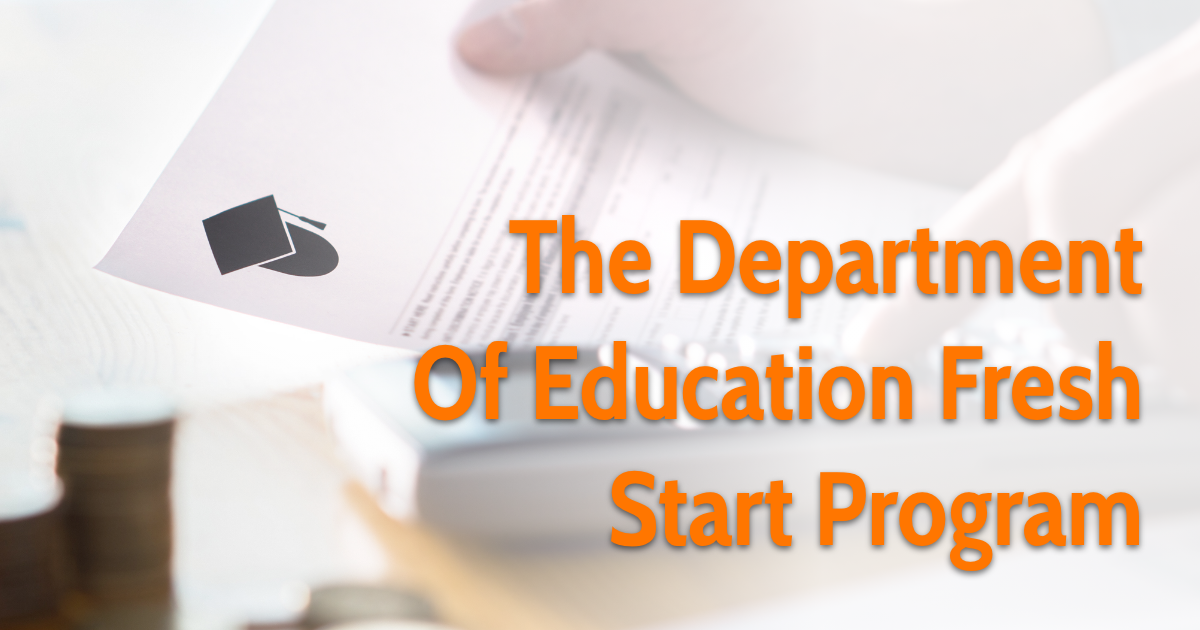
If you are one of the approximately 7.5 million federal student loan borrowers with defaulted loans, you will want to take full advantage of the Fresh Start Program being offered by the Department of Education. If properly utilized, this program will allow you to rehabilitate your loans, get them back on a regular payment schedule, and can also help lower your payments.
What is the Fresh Start Program?
The Fresh Start Program is a one-time temporary program, offered by the Department of Education, that allows borrowers with defaulted federal student loans to get temporary relief from collection activity, and to get more permanent relief by getting out of default and getting back on a regular payment schedule.
How does Fresh Start Work?
Some people believe, incorrectly, that the Fresh Start program is automatic, and permanently cured their default. However, that is not the case. There are in fact two parts to the program.
The first part of Fresh Start is automatic, and it puts a temporary pause on all collection activity with respect to a defaulted student loan. The pause stops wage garnishments, offsets of government payments like tax refunds or Social Security benefits, and all other attempts to collect the defaulted loan. During the pause, there also will not be any collection costs charged.
The second part of Fresh Start is not automatic, and to take advantage of it, you have to take the necessary steps to enroll. If you enroll in Fresh Start, your loans will be taken out of default. The loans will be transferred to a loan servicer and returned to “in repayment” status. And the record of default will be removed from your credit report. Importantly, the loans will also become eligible for income-dependent repayment plans, which can significantly lower your monthly payments.
Normally, you only have one chance to rehabilitate a defaulted federal loan. An additional benefit of Fresh Start is that it does not count as your one chance to rehabilitate. So if you have defaulted and rehabilitated before, you are still able to use Fresh Start. And, if Fresh Start is your first time getting out of default, you still retain the ability to rehabilitate in the future if you happen to again default on the same loans.
Which Loans Are Eligible for Fresh Start?
Not all federal student loans are eligible for Fresh Start. The eligible loans are:
- Defaulted William D. Ford Federl Direct Loan Program loans (Direct Loans)
- Defaulted Federal Family Education Loan Program loans (FFEL Loans)
- Defaulted Perkins Loans held by the Department of Education
Loans that are not eligible for Fresh Start are:
- Defaulted Perkins Loans held by schools
- Defaulted Health Education Assistance Loan Program loans (HEAL Loans)
- Student loans in ongoing litigation by the Department of Justice
- Direct Loans and FFEL Loans that default after the end of the COVID-19 student loan payment pause (the payment pause ended in October 2023)
When Does Fresh Start End?
The Fresh Start Program ends in September 2024.
What Happens If I Do Not Enroll In Fresh Start Before It Ends?
If you do not enroll in Fresh Start before it ends, then your loans will remain in default, and all collection activity will resume starting in October 2024. You may still be able to use the regular rehabilitation process to get your loans out of default, but if you had previously rehabilitated the same loans, then rehabilitation may no longer be an option.
Need assistance with enrolling in Fresh Start? Schedule a student loan evaluation with a Student Loan Attorney.
For more information on dealing with student loan debt, read our Ultimate Guide to Eliminating Student Loans.
The above is provided for general informational purposes only. It is not intended to and does not constitute legal advice, and does not create an attorney-client relationship. If you need legal advice for your specific situation, you should contact a qualified attorney in your area.

